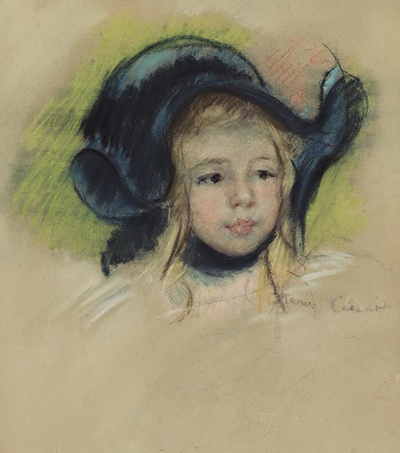Simone was a young girl who appeared in a good number of Mary Cassatt drawings and paintings over a period of several years. There are even several different versions of this sketch of her wearing a Green Bonnet with Wavy Brim alone.
We do not have a huge amount of information available on this portrait, but by comparing it to related artworks we can place it around 1904. The artist had moved out of Paris into the French countryside and found several models in a nearby town who proved entirely suitable to her work. Simone would become her favorite and is believed to have appeared in around twenty different artworks, most of which were pastel-based as these were quicker to complete. She loved to concentrate on colour over form, and pastels worked well in that regard. This was also one of the focuses of the Impressionists who took in several female painters, and helped them to achieve the academic respect that would have been difficult to gain on their own, such were the barriers that they experienced at that time. Their success has helped other artists following on afterwards, and more generally helped to re-shape opinions on what women could achieve if given the opportunity.
Simone here looks to our right hand side whilst wearing a dark green hat which looks almost black. It has a wavy brim as mentioned in the title and stretches to far beyond the dimensions of her own face. It catches a little bit of light from above on the edges of the bonnet. Cassatt then strikes some tones of a lime green across the background to seperate the portrait from the natural tone of the paper. The young girl also has a black strap which she wears below her chin, which helps to keep the bonnet in place on a windy day. The artist uses some touches of pastels below this to suggest at form, but generally leaves the whole bottom half blank, which is something that she regularly did in her pastel portraits. She then signed the piece on the right hand side. It is the facial features which receive the most attention, and this area is properly finished, without any need for an extension of imagination to fill in the blanks.
It was in the 1890s that Cassatt started to work more often with the medium of pastels, and she would appreciate the combination of drawing and colour, believing that this was well suited to her portraits in particular. She was excited by the achievements of Edgar Degas who also adored this art form and they together helped to raise its respect within art circles, as previously pastel work had not really been taken seriously. Degas himself remains best known for portraits of ballerinas, more so in oils, and some of his most famous paintings included Ballet Class, Dance Class and also Blue Dancers, though the total number ran into the many hundreds, such was his devotion to this genre.




